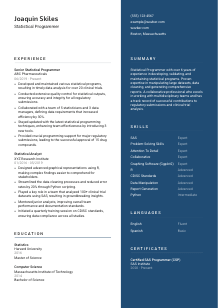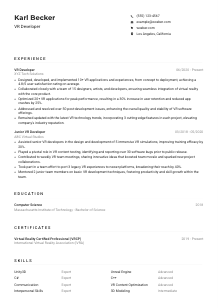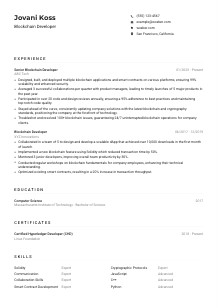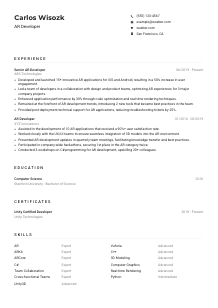Statistical Programmer Resume Example
Crunching data, but your resume seems skewed? Delve into this Statistical Programmer resume example, refined with Wozber free resume builder. Discover how you can cluster your statistical skills to meet job requirements, positioning your career trajectory on a perfectly normal distribution!
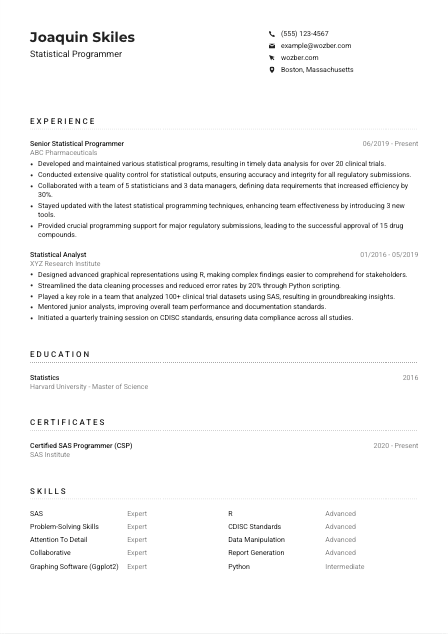
How to write a Statistical Programmer Resume?
Stepping into the role of a Statistical Programmer requires more than just having the right skill set; it requires presenting those skills in a resume that speaks volumes. This is where your journey begins—with crafting a resume so compelling, so precisely targeted, that it secures your spot in the interview room. Discover the art of resume writing with the Wozber free resume builder. This guide is peppered with tailored advice, stirring you towards utilizing ATS-friendly resume templates and achieving ATS optimization, ensuring your resume sails smoothly through Applicant Tracking Systems.
Ready to embark on this crucial voyage? Let's unlock the secrets to drafting your masterstroke!
Personal Details
Kickstart your resume with a personal touch. This initial handshake with potential employers needs to resonate professionalism while encapsulating all that makes you the perfect candidate. Follow these steps for a personal introduction that creates a lasting impression.
1. Brand Yourself Right
Think of your name as your personal logo. It should grab attention. Opt for a bold, clear font. Place your job title — in this case, 'Statistical Programmer' — prominently beneath your name to anchor your expertise right off the bat.
2. Serve the Essentials on a Silver Platter
Your contact information is your invite to further conversations. A professional email and a phone number are must-haves. Ensure these details are mistake-free to maintain your credibility.
3. Location, Location, Location
Mentioning 'Boston, Massachusetts' not just meets a job requirement but also subtly assures the employer of your logistical compatibility. It's a small but critical detail that aligns perfectly with the job's geo-preference.
4. Digital Presence
In today's interconnected world, a LinkedIn profile or a professional website can differentiate you. Ensure it's a mirror reflection of your resume, showcasing your consistency and attention to detail.
5. Keep It Professional
Stick to the essentials. Omit any personal details not directly relevant to your application to maintain professionalism and focus on what truly matters—your suitability for the role.
Takeaway
First impressions are gold. Your personal details section is the cornerstone, setting a professional and precise tone. Make each detail count, ensuring they lead seamlessly into your professional narrative. Remember, perfection lies in the details.





Experience
The experience section is the backbone of your resume, your chance to show rather than tell. Aligning your past achievements with the job you're targeting is crucial. Let's delve into constructing an experience section that mirrors the job description, emphasizing ATS optimization.
- Developed and maintained various statistical programs, resulting in timely data analysis for over 20 clinical trials.
- Conducted extensive quality control for statistical outputs, ensuring accuracy and integrity for all regulatory submissions.
- Collaborated with a team of 5 statisticians and 3 data managers, defining data requirements that increased efficiency by 30%.
- Stayed updated with the latest statistical programming techniques, enhancing team effectiveness by introducing 3 new tools.
- Provided crucial programming support for major regulatory submissions, leading to the successful approval of 15 drug compounds.
- Designed advanced graphical representations using R, making complex findings easier to comprehend for stakeholders.
- Streamlined the data cleaning processes and reduced error rates by 20% through Python scripting.
- Played a key role in a team that analyzed 100+ clinical trial datasets using SAS, resulting in groundbreaking insights.
- Mentored junior analysts, improving overall team performance and documentation standards.
- Initiated a quarterly training session on CDISC standards, ensuring data compliance across all studies.
1. Dissect the Job Description
Extract duties and technologies mentioned, like 'data validation', 'CDISC standards', and statistical programming languages. These are your keywords—a beacon for ATS optimization.
2. Chronological Clarity
Display your experience in reverse chronological order. For each role, concisely list your job title, company name, and employment dates. Aim for ATS-friendly formatting for seamless parsing.
3. Align and Achieve
Under each role, craft bullet points that not only align with the job requirements but also quantify your achievements. Discuss the clinical trials you've propelled and the regulatory submissions you've supported.
4. Numbers Speak Louder
Quantifying your accomplishments provides tangible proof of your capabilities and impact. If you enhanced efficiency by 30%, as in the resume example, it tells a compelling story of your contribution.
5. Relevance is Key
Maintain an unwavering focus on what's pertinent to your role as a Statistical Programmer. Resonance with the job description should guide the selection of experiences you choose to highlight.
Takeaway
A well-crafted experience section speaks volumes. It not only presents you as the ideal candidate but also ensures ATS-friendliness. Each bullet point should be a testament to your contributions and alignment with the Statistical Programmer role—highlighting, quantifying, and tailoring your journey.
Education
For a Statistical Programmer, your educational background is the bedrock that supports your expertise. Tailoring this section to reflect the job's specific demands showcases your preparedness for the role.
1. Match the Degree Requirements
Start by echoing the exact educational prerequisites stated in the job description. A 'Bachelor's degree or higher in Statistics, Computer Science, or a related field' instantly checks a critical criterion.
2. Keep It Streamlined
Focus on clarity and brevity. List your highest level of education first, followed by any pertinent degrees, including the institution and graduation year.
3. Degree Specificity
Directly list your 'Master of Science in Statistics' and 'Bachelor of Science in Computer Science', mirroring the job specification. This clear alignment amplifies your fit for the role.
4. Relevant Coursework
While not always necessary, emphasizing relevant courses can add depth, especially if they're directly applicable to the challenges of a Statistical Programmer.
5. Above and Beyond
If you have other educational accolades that underscore your suitability—think relevant projects, honors, or clubs—include them. For senior roles, however, keep the focus on degree relevancy and professional accomplishments.
Takeaway
Your education section is more than a formal requirement; it's a testament to your foundational expertise. Ensuring it's tailored, clear, and reflective of the job's demands not only validates your qualification but also strengthens your overall candidacy.
Certificates
In the world of statistical programming, certifications can serve as the cherry on top, validating your dedication to staying on the cutting edge. Here's how you can incorporate these into your resume.
1. Identify Job-Related Certificates
For roles where specific certifications aren't mentioned, choose those that align closest with the job's technological and methodological requirements. For instance, a 'Certified SAS Programmer' certificate demonstrates proficiency in a key statistical programming language.
2. Selection Over Volume
Given the choice, prioritize certificates that are most relevant and prestigious within your field. This targeted approach ensures your resume remains aligned with the statistical programming domain.
3. Dates Matter
Including the date of acquisition, especially for recent certificates, places emphasis on your commitment to continuous professional development, a trait highly valued in dynamic fields.
4. Stay Ahead
The landscape of statistical programming is ever-evolving. Showcasing ongoing learning and up-to-date certifications signals your adaptability and eagerness to stay informed about the latest methodologies and tools.
Takeaway
Carefully selected certifications tell a story of your dedication to excellence and professional growth in statistical programming. They underscore your specialized skills, making you a more compelling candidate. Keep learning, and let your resume reflect your commitment.
Skills
The Skills section of your resume is where you get to showcase your technical prowess and soft skills. For a Statistical Programmer, this balance is crucial. Let's fine-tune this section to speak directly to your target role.
1. Pinpoint Precise Skills
Extract the skills directly mentioned in the job description, such as 'SAS', 'problem-solving skills', and 'CDISC standards'. These are your keywords for ATS optimization and must feature prominently in your skills list.
2. Quality Over Quantity
While it might be tempting to list every skill under the sun, focus on those that truly matter for a Statistical Programmer. Prioritizing quality over quantity ensures your most relevant skills shine.
3. Organized Presentation
Arrange your skills in a logical order, starting with your strongest technical skills, followed by methodological expertise and soft skills. This structured approach aids in readability and immediate impact.
Takeaway
Your skills section is a testament to your capabilities. By mirroring the job description and emphasizing the most relevant skills, you craft a compelling narrative of why you're the ideal candidate. Keep honing these skills; they're the tools that will forge your path ahead.
Languages
In a field as global as statistical programming, linguistic skills can distinguish you in a crowded candidate pool. Here's how to leverage your multilingual abilities effectively.
1. Highlight Necessities
"Must have the ability to converse fluently in English." Fulfiling this requirement is your first priority. Ensure your proficiency in English is clearly noted, ideally at 'Fluent' to reflect the job requirement.
2. Additional Assets
Besides English, listing other languages you're proficient in can underscore your readiness for global projects or teams. It's a subtle nod to your adaptability and cultural awareness.
3. Honesty in Proficiency
Clearly state your level of proficiency for each language. This honesty ensures that expectations are aligned and can prevent any miscommunications in the future.
4. Match the Job's Scope
When considering which languages to include, think about the role's requirements and potential international scope. Matching your linguistic skills to the job's geographical or cultural context can be a decisive factor.
5. Reflect and Relate
While the primary focus for a Statistical Programmer role might be technical skills, languages reflect your ability to communicate and collaborate effectively, traits that enrich any professional profile.
Takeaway
A well-considered Languages section can subtly enhance your candidacy, painting you as a well-rounded, globally aware professional. Your linguistic repertoire is a complement to your technical skills, presenting you as a versatile and adaptable candidate.
Summary
Your Summary is the prologue to your professional story, setting the stage for what's to come. For a Statistical Programmer, it's your moment to encapsulate your expertise and aspirations, drawing in the reader with precision and insight.
1. Grasp the Job's Core
Begin by internalizing the foundational demands of the role: "Statistical Programmer with over 6 years of experience... successful contributions to regulatory submissions and clinical trial analysis." This sets a solid basis for your summary.
2. Start with a Strong Lead
Introduce yourself with confidence, highlighting your professional designation and years of experience right from the start. Let the reader know immediately who they're dealing with—a seasoned Statistical Programmer.
3. Link Skills to Successes
Weave your core skills and standout achievements into your summary, using them as proof points of your capability and impact. This linkage acts as a compelling preview of the detailed accomplishments listed later.
4. Conciseness is Key
Craft your summary to be potent and to the point, serving as an engaging teaser that invites the hiring manager to delve deeper. An effective summary captures attention and cements your candidacy in the reader's mind.
Takeaway
The Summary is your resume's opening act, setting the tone for your whole application. It's where you succinctly declare your qualifications and readiness for the role. Nail this, and you've built a strong foundation for a resume that's not just ATS-compliant but deeply compelling.
Launching Your Statistical Programmer Journey
Congratulations on meticulously crafting a resume that showcases your expertise with precision and persuasiveness. By following these tips and employing the Wozber free resume builder, complete with ATS-friendly resume templates and ATS resume scanner, you're not just prepared; you're positioned to excel. Your story is compelling, your skills finely honed, and your resume, a beacon of professionalism. Now, step forward with confidence.
The path to success as a Statistical Programmer is well-lit with your refined resume leading the way. Your next big opportunity awaits!

- Bachelor's degree or higher in Statistics, Computer Science, or a related field.
- Minimum of 3 years of programming experience in at least one statistical programming language (e.g., SAS, R, Python).
- Strong proficiency in manipulating large datasets, data cleaning, and report generation.
- Knowledge of clinical trials and experience with CDISC standards.
- Exceptional problem-solving skills, attention to detail, and a collaborative mindset.
- Must have the ability to converse fluently in English.
- Must be located in Boston, MA.
- Develop and maintain statistical programs for data analysis, including tables, listings, and graphs.
- Conduct quality control and data validation to ensure accuracy and integrity of statistical outputs.
- Collaborate with statisticians and data managers to define data requirements and develop statistical deliverables.
- Stay updated with the latest statistical programming techniques and tools to enhance efficiency and effectiveness.
- Provide programming support for regulatory submissions and responses.






